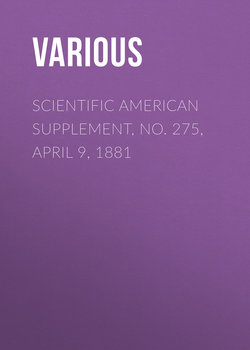Scientific American Supplement, No. 275, April 9, 1881

Реклама. ООО «ЛитРес», ИНН: 7719571260.
Оглавление
Various. Scientific American Supplement, No. 275, April 9, 1881
WHEAT AND WHEAT BREAD
ANATOMICAL STRUCTURE AND CHEMICAL COMPOSITION OF WHEAT
ENVELOPES OF THE BERRY
ENVELOPES AND TISSUES OF THE BERRY PROPER
ENDOSPERM OR FLOURY PORTION, NOS. 7, 8, 9
THE EMBRYO AND THE COATING OF THE EMBRYO
THE ORIGIN OF NEW PROCESS MILLING
THE MILLING STRUCTURES AND MACHINERY
DIRECT FOREIGN TRADE
THE GUENON MILK-MIRROR
TWO GOOD LAWN TREES
CUTTING SODS FOR LAWNS
HORTICULTURAL NOTES
OBSERVATIONS ON THE SALMON OF THE PACIFIC
THE RELATION BETWEEN ELECTRICITY AND LIGHT.1
INTERESTING ELECTRICAL RESEARCHES
MEASURING ELECTROMOTIVE FORCE
TELEPHONY BY THERMIC CURRENTS
THE TELECTROSCOPE
TRANSMITTER
RECEIVER
THE VARIOUS MODES OF TRANSMITTING POWER TO A DISTANCE.2
GENERAL RESULTS
THE HOTCHKISS REVOLVING GUN
THALLIUM PAPERS AS OZONOMETERS
THE AUDIPHONE IN ENGLAND
CONDUCTIVITY OF MOIST AIR
FLOATING PONTOON DOCK
WEIRLEIGH, BRENCHLEY, KENT
RAPID BREATHING AS A PAIN OBTUNDER IN MINOR SURGERY, OBSTETRICS, THE GENERAL PRACTICE OF MEDICINE AND OF DENTISTRY.3
ADDENDA
TAP FOR EFFERVESCING LIQUIDS
CHEMICAL SOCIETY, LONDON, JAN. 20, 1881
PROF. H.E. ROSCOE, President, in the Chair
ROSE OIL, OR OTTO OF ROSES
A NEW METHOD OF PREPARING METATOLUIDINE
THE SCIENTIFIC AMERICAN SUPPLEMENT
PUBLISHED WEEKLY
PATENTS
Отрывок из книги
In consequence of the interest that has been recently excited on the subject of bread reform, we have, says the London Miller, translated the interesting contribution of H. Mège-Mouriès to the Imperial and Central Society of Agriculture of France, and subsequently published in a separate form in 1860, on "Wheat and Wheat Bread," with the illustration prepared by the author for the contribution. The author says: "I repeat in this pamphlet the principal facts put forth in the notes issued by me, and in the reports furnished by Mr. Chevreul to the Academy of Science, from 1853 up to 1860."
The study of the structure of the wheat berry, its chemical composition, its alimentary value, its preservation, etc., is not alone of interest to science, agriculture, and industry, but it is worthy of attracting the attention of governments, for this study, in its connection to political economy, is bound up with the fate and the prosperity of nations. Wheat has been cultivated from time immemorial. At first it was roughly crushed and consumed in the form of a thick soup, or in cakes baked on an ordinary hearth. Many centuries before the Christian era the Egyptians were acquainted with the means of making fermented or leavened bread; afterwards this practice spread into Greece, and it is found in esteem at Rome two centuries B.C.; from Rome the new method was introduced among the Gauls, and it is found to-day to exist almost the same as it was practiced at that period, with the exception, of course, of the considerable improvements introduced in the baking and grinding.
.....
I make a distinction here as is seen, between the action through being present, and the action of real ferments, but it is not my intention to approve or disapprove of the different opinions expressed on this subject. I make use of these expressions only to explain more clearly the phenomena I have to speak of, for it is our duty to bear in mind that the real ferments only act after a longer or shorter period of development, while, on the other hand, the effects through presence are immediate.
I now return to the embryous membrane. Various causes increase or decrease the action of this tissue, but it may be said in general that all the agents that kill the embryous membrane will also kill the cerealine. This was the reason why I at first attributed the production of dark bread exclusively to the latter ferment, but it was easy to observe that during the baking, decompositions resulted at over 158° Fah., while the cerealine was still coagulated, and that bread containing bran, submitted to 212° of heat, became liquefied in water at 104°. It was now easy to determine that dark flours, from which the cerealine had been removed by repeated washings, still produced dark bread. It was at this time, in remembering my experiences with organic bodies, I determined the properties of the insoluble tissue, deprived of the soluble cerealine, with analogous properties, but distinguished not alone by its solid organization and state of insolubility, but also by its resistance to heat, which acts as on yeast. There exists, in reality, I repeat, a resemblance between the embryous membrane and the yeast; they have the same immediate composition; they are destroyed by the same poisons, deadened by the same temperatures, annihilated by the same agents, propagated in an analogous manner, and it might be said that the organic tissues endowed with life are only an agglomeration of fixed cells of ferments. At all events, when the blades of the embryous membrane, prepared as already stated, are exposed to a water bath at 212°, this tissue, in contact with the diluted starch, produces the same decomposition; the contact, however, should continue two or three hours in place of one. If, instead of placing these membranes in the water bath, they are enveloped in two pounds of dough, and this dough put in the oven, after the baking the washed membranes produce the same results, which especially proves that this membrane can support a temperature of 212° Fah. without disorganization. We shall refer to this property in speaking of the phenomena of panification.
.....